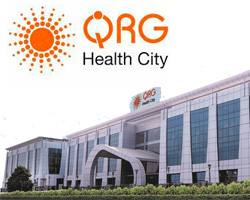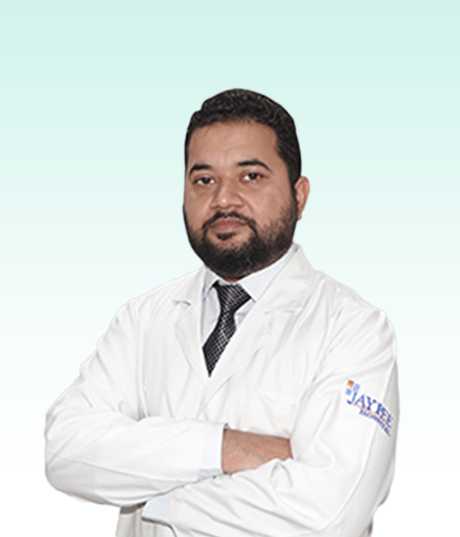Myringoplasty
Myringoplasty is a surgery done to repair a ruptured eardrum. Your eardrum (tympanic membrane) is a thin, dime-sized piece of tissue located between your middle ear and outer ear. It helps you hear by vibrating in response to sound waves. Your eardrum can tear or rupture as a result of ear infections, head trauma, sticking objects in your ear, sudden loud noises, and more. Myringoplasty repairs the hole in your eardrum and reduces your risk for further health issues such as vertigo, mastoiditis (an infection of the bone behind your ear), and, in severe cases, permanent hearing loss.

Who Needs Myringoplasty
Myringoplasty may be recommended for individuals who:
Tympanic Membrane Perforation: Have a perforated eardrum, often due to chronic ear infections, injury, or other causes.
Hearing Loss: Experience hearing loss associated with the perforation, which affects their quality of life and communication.
Chronic Ear Infections: Suffer from recurring ear infections that do not respond to non-surgical treatments and contribute to eardrum damage.
When to See a Specialist
If you or your child has persistent ear infections, hearing loss, or a perforated eardrum, it’s essential to consult an ear, nose, and throat (ENT) specialist. They can evaluate the condition, determine the extent of the tympanic membrane damage, and recommend Myringoplasty if necessary.
Procedure
Anesthesia: The procedure is often performed under local or general anesthesia, depending on the patient’s age and medical condition.
Incision: The surgeon makes an incision in the ear canal or behind the ear to access the tympanic membrane.
Tympanic Membrane Repair: The surgeon carefully trims and cleans the edges of the perforation. They then use tissue grafts, which can be sourced from the patient’s own body or synthetic materials, to patch the perforation.
Closure: The incision is closed with sutures or surgical glue, and a sterile dressing may be applied.
Road To Recovery
Recovery from Myringoplasty involves:
Hospital Stay: Myringoplasty is often performed as an outpatient procedure, and patients can return home the same day.
Pain Management: Over-the-counter or prescription pain medications may be needed initially.
Follow-up Appointments: Regular follow-up visits with the surgeon to monitor healing and assess the surgical outcome.
Hearing Evaluation: Assessments of hearing function may be conducted to determine the effectiveness of the surgery in restoring hearing.
Risk Management
Myringoplasty is generally considered a safe procedure, but like any surgery, it carries potential risks, including:
Infection: Proper wound care and antibiotic use help reduce the risk of infection.
Hearing Loss: While the goal is to restore or improve hearing, there is a risk of temporary or permanent hearing loss.
Scar Tissue Formation: Scar tissue may form at the surgical site, potentially affecting hearing.
Graft Failure: In some cases, the graft used to repair the tympanic membrane may not fully adhere, requiring revision surgery.
Benefits of Myringoplasty
The benefits of Myringoplasty include:
Restored Hearing: Successful surgery can significantly improve or restore hearing function.
Reduced Infection Risk: Closure of the perforation reduces the risk of recurrent ear infections.
Improved Quality of Life: Patients often experience enhanced quality of life with improved hearing and reduced ear discomfort.
Frequently Asked Questions
How long does the procedure take?
The duration of Myringoplasty varies but typically takes one to two hours.
Is this surgery painful?
Patients may experience some discomfort after surgery, which can be managed with pain medications prescribed by the surgeon.
Will there be scarring after Myringoplasty?
Scarring is minimal and usually concealed within the ear canal or behind the ear.
When can I return to regular activities?
Recovery times vary, but most patients can gradually resume regular activities within a few weeks, with some restrictions.
Can Myringoplasty completely restore my hearing?
The extent of hearing improvement can vary from person to person and depends on individual factors and the nature of the eardrum damage. In many cases, Myringoplasty results in significant hearing improvement.
Treatment Plans
- Trauma & intensive care $59
- Aged Care $29
- Community Services $25
- Diagnosis & Investigation $48
- Medical & Surgical $82
- Mental Health $74
- Rehabitation $24
- Specialised Support Service $19
- Trauma & intensive care $59
- Aged Care $29
- Community Services $25
- Diagnosis & Investigation $48
- Medical & Surgical $82
- Mental Health $74
- Rehabitation $24
- Specialised Support Service $19
Treatians As The Best Choice
Treatians understand that seeking medical treatment abroad can be a daunting experience for patients and their families. That’s why the company offers end-to-end support to its clients, from the initial consultation to post-treatment care. The company provides personalized treatment plans that are tailored to meet the individual needs of each patient, and its team of dedicated professionals is always on hand to provide guidance and support throughout the entire process. Contact us at +91-7982312582, drop your email [email protected]
- Trauma & intensive care
- Aged Care
- Community Services
- Diagnosis & Investigation
- Medical & Surgical
- Mental Health
- Rehabitation
- Specialised Support Service
Service Recipient Says

Oxmox advised her not to do so, because there were thousands of bad Commas, wild Question Marks and devious.
Kolis Muller NY Citizen
Oxmox advised her not to do so, because there were thousands of bad Commas, wild Question Marks and devious.
Kolis Muller NY Citizen



















Oxmox advised her not to do so, because there were thousands of bad Commas, wild Question Marks and devious.
Kolis Muller NY Citizen